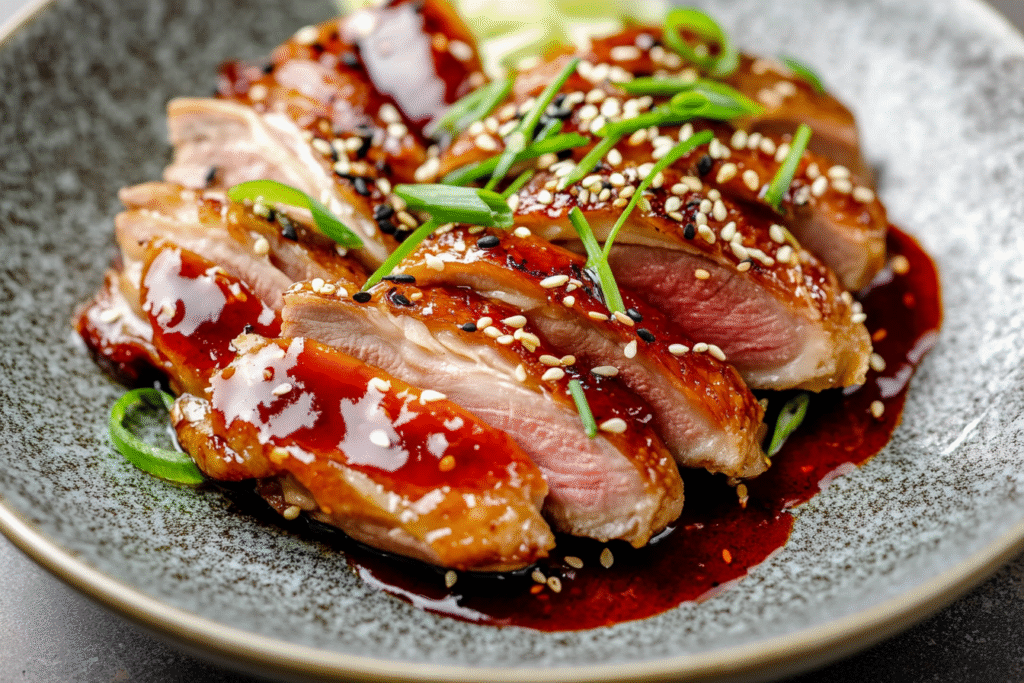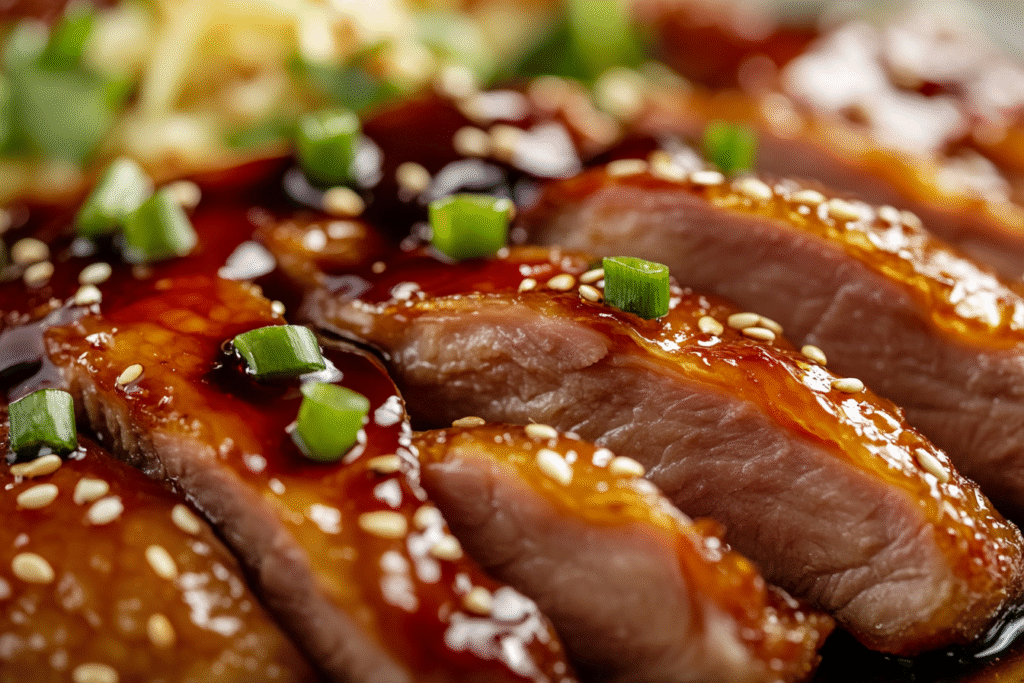Introduction: Why Crispy Duck with Plum Sauce is Worth Mastering
Few dishes deliver the level of elegance and flavor contrast as beautifully as Crispy Duck with Plum Sauce. The crackling, golden skin paired with tender, succulent meat, all balanced by the sweet, tangy richness of homemade plum sauce, is a culinary experience usually reserved for restaurants. But the truth is—you can absolutely create this show-stopping dish in your own kitchen.
This recipe demystifies the process and breaks it down into manageable, step-by-step guidance, making it not only achievable but deeply satisfying to make at home. Whether you’re aiming to impress guests at a dinner party, preparing a special occasion meal, or simply indulging in a gourmet craving, this crispy duck will transport your taste buds to something truly memorable.
The beauty of this dish lies in its balance: the salty, crispy skin meets the juicy duck meat, which is then brightened by the sweet acidity of plum sauce. Paired with light sides like steamed bok choy, jasmine rice, or fresh scallions and cucumber, this dish hits all the right notes.
Let’s explore every detail—from ingredient selection and preparation strategies to potential challenges and thoughtful variations—so you can confidently bring restaurant-quality crispy duck to your table.

Ingredient Selection: Choosing the Right Duck and Plums
Duck:
For this recipe, we’ll focus on duck legs (duck confit style) or whole duck breasts with skin on. Duck legs tend to produce juicier, more forgiving results for beginners, while duck breasts offer quicker cooking and a more refined presentation.
Key things to look for:
- Fresh, skin-on duck legs or breasts with a thick, even layer of skin.
- Avoid skinless cuts—they will not produce the necessary crispy texture.
Plums:
Choose ripe but firm plums for the sauce. The natural sweetness and tartness of fresh plums balance the richness of the duck.
Plum variety tips:
- Black or red plums yield a deeper, more complex sauce.
- Yellow plums produce a lighter, slightly more tart sauce.
If fresh plums aren’t available, you can substitute:
- Canned plums (in juice, not syrup)
- Plum preserves (reduce added sugar in the sauce if using)

Additional Flavor Builders:
- Chinese five-spice powder: Infuses the duck with a subtle aromatic depth.
- Soy sauce and rice vinegar: Essential for balancing the plum sauce.
- Honey: Adds a gentle sweetness to both the duck glaze and sauce.
Equipment Recommendations: Tools for Perfect Crispiness
You’ll need:
- A sharp knife for scoring the duck skin.
- A heavy-bottomed skillet (preferably cast iron) to render the fat evenly.
- A roasting rack or wire rack to elevate the duck during oven roasting.
- A small saucepan for making the plum sauce.
- Tongs or a slotted spoon for flipping duck pieces carefully.
Optional but helpful:
- A fat separator to easily reserve duck fat.
- A meat thermometer to ensure perfect doneness.
Preparation Strategies: How to Plan for Crispy Success
Advance Prep:
- The plum sauce can (and should) be made a day in advance. It improves as it sits, allowing flavors to meld.
- You can season and air-dry the duck (uncovered in the fridge) overnight for maximum skin crispiness.
Scoring the Duck Skin:
- Use a sharp knife to make shallow diagonal cuts across the skin, being careful not to pierce the meat. This helps the fat render out efficiently and crisps the skin.
Air-Drying:
- Leaving the seasoned duck uncovered in the refrigerator overnight is a key restaurant trick that promotes ultra-crispy skin.
Resting the Duck:
- Always let the cooked duck rest for at least 5-10 minutes to retain its juices.
Common Challenges and How to Avoid Them
Soggy Skin:
- Ensure the duck is patted completely dry before cooking.
- Proper scoring and air-drying are crucial.
- Start skin-side down in a cold pan to render fat slowly.
Overcooked Duck:
- For duck breast, aim for medium doneness (135°F / 57°C internal temperature).
- For duck legs, low and slow roasting yields fall-off-the-bone tenderness.
Thin or Bland Plum Sauce:
- Reduce the sauce sufficiently until it coats the back of a spoon.
- Taste and adjust for sweetness, acidity, and salt.
Flavor Boosters and Variations
- Spice it up: Add a small piece of fresh ginger or a pinch of chili flakes to the plum sauce.
- Herbal twist: Finish with fresh thyme or star anise in the sauce for extra depth.
- Asian flair: A splash of hoisin sauce in the plum sauce adds a savory note.
Dietary Substitutions
- Gluten-Free: Use tamari instead of soy sauce.
- Low-Sugar: Reduce the honey and balance with more rice vinegar or lemon juice.
- Vegan Adaptation: Substitute duck with crispy roasted tofu or mushrooms and make a plant-based plum sauce.
Ingredient List
For the Duck:
- 4 skin-on duck legs or 2 large duck breasts
- 1 teaspoon salt
- ½ teaspoon black pepper
- ½ teaspoon Chinese five-spice powder
For the Plum Sauce:
- 4 ripe plums, pitted and chopped
- 1 tablespoon soy sauce (or tamari for gluten-free)
- 2 tablespoons honey
- 1 tablespoon rice vinegar
- 1 tablespoon brown sugar
- 1 small garlic clove, minced
- ½ cup (120 ml) water
- Optional: pinch of chili flakes, fresh ginger slice, or star anise
Optional Garnishes:
- Thinly sliced scallions
- Sesame seeds
- Fresh cilantro
Step-by-Step Instructions
Step 1: Prep the Duck
Pat the duck legs or breasts dry with paper towels. Score the skin in a crisscross pattern, being careful not to cut into the meat.
Season both sides with salt, pepper, and Chinese five-spice powder.
(Optional: For best results, place the duck uncovered in the refrigerator overnight to air-dry.)
Step 2: Make the Plum Sauce
In a small saucepan over medium heat, combine plums, soy sauce, honey, rice vinegar, brown sugar, garlic, and water.
Bring to a simmer and cook for 15-20 minutes, stirring occasionally, until the plums break down and the sauce thickens.
For a smooth sauce, blend with an immersion blender or strain through a fine sieve. For a rustic sauce, leave it chunky.
Taste and adjust with more honey, vinegar, or soy sauce as needed. Set aside.
Step 3: Render the Duck Fat
Place the duck skin-side down in a cold, dry skillet. Turn the heat to medium.
Cook for 8-10 minutes, allowing the fat to slowly render out and the skin to become golden and crispy.
Flip and sear the other side for 2-3 minutes.
Step 4: Roast the Duck
Transfer the duck to a wire rack set over a baking sheet.
For duck legs: Roast in a preheated 375°F (190°C) oven for 25-30 minutes until fully cooked and crispy.
For duck breasts: Roast for 6-8 minutes until internal temperature reaches 135°F (57°C) for medium.
Rest the duck for 5-10 minutes before slicing.
Step 5: Serve
Serve the crispy duck with generous spoonfuls of plum sauce. Garnish with scallions, sesame seeds, or fresh cilantro if desired.
Accompany with jasmine rice, steamed bok choy, or a simple cucumber salad.
Troubleshooting & FAQs
Why isn’t my duck skin crispy?
Ensure you started skin-side down in a cold pan and rendered enough fat. Pat the skin dry thoroughly before cooking.
Can I make the plum sauce ahead?
Yes, it stores beautifully in the fridge for up to 4 days and can also be frozen.
Can I use store-bought plum sauce?
You can, but homemade sauce offers a much fresher, more balanced flavor.
Can I use a whole duck?
Yes, but cooking times and techniques will differ. A whole duck typically requires low and slow roasting with basting.
Storage & Reheating
Store leftover duck and plum sauce in separate airtight containers in the fridge for up to 3 days.
Reheat the duck in the oven at 350°F (175°C) for 10-15 minutes to re-crisp the skin.
The plum sauce can be reheated gently on the stovetop or in the microwave.
Variations: Crispy Duck vs. Peking Duck vs. Confit Duck
- Crispy Duck: Focuses on golden, crunchy skin with a simple, flavorful preparation. Typically pan-seared and roasted.
- Peking Duck: Air-dried and glazed, roasted whole, traditionally served with pancakes, scallions, and hoisin.
- Confit Duck: Slow-cooked submerged in duck fat for fall-apart tenderness.
This crispy duck recipe is a simplified, home-friendly version that delivers fantastic texture and flavor without complex equipment or techniques.


